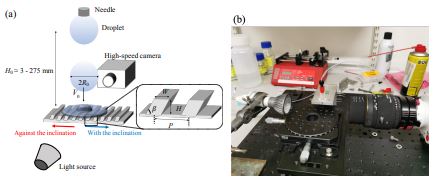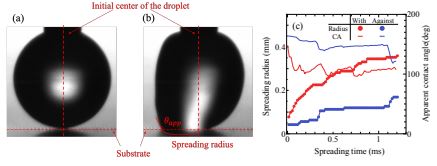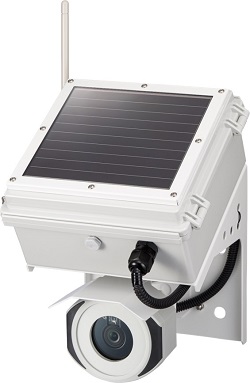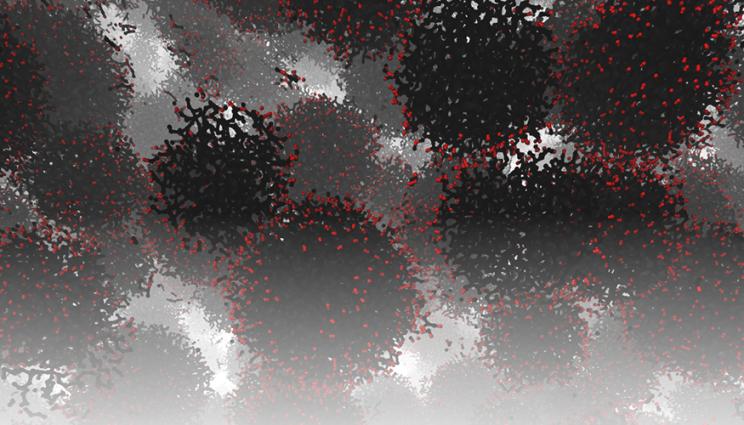2022-03-16 スウェーデン王・王立工科大学(KTH)
本研究は、構造化された表面における液滴の運動の基礎的なメカニズムを解明することを目的としている。
研究対象は、傾斜したマイクロリッジとマイクロピラーからなるアレイ状の表面である。
高速度カメラによる液滴散布実験と、同等の液滴を用いた数値シミュレーションにより、急速な濡れや液滴衝突の状況を研究している。
本論文では、まず実験と数値シミュレーションを組み合わせて非対称な微細構造上の拡がり機構を明らかにし、表面形状の影響を予測する理論モデルを提示して、「接触線速度がどの程度影響を受けるか」という問いに答えるものである。
また、微細構造とともに、液滴の拡がりに対する添加物の影響を調べ、複雑な流体物性の影響を調査しています。

図3.1: (a)実験装置の概略図、(b)実験装置の写真。
高速度カメラで液滴を観察する。

図3.2: 自然拡散実験における液滴のスナップショット。
(a) 液滴が広がり始める前の1フレーム
(b) 液滴が広がり始めてから0.54 ms後を広げる。図では、非対称のの微細構造。
実験中の液滴の中の白い部分は、回折した光源からの光
(c) 測定した拡がり半径の例と見かけの接触角 表面は親水性の傾斜したマイクロリッジ。
<関連情報>
Rapid wetting – influence of surface geometry and fluid properties
Doctoral student: Susumu Yada ,
ISBN: 978-91-8040-145-6 (print)OAI: oai:DiVA.org:kth-308990DiVA, id: diva2:1638950
Abstract
Wetting of a liquid on a solid surface is ubiquitous in everyday life, such as morning dew on a plant leaf and raindrops hitting on a glass window. However, this phenomenon is far away from being completely understood. Its dynamics are complicated due to its physics which involves multi-length scales from molecular motions to macroscopic fluid motions as well as numerous parameters such as viscosity, surface tension, contact angles, and so on. Moreover, the situation becomes more complicated in rapid situations – initial rapid wetting and droplet impact.
Not only the understanding of contact line physics and wetting on complete surfaces from a theoretical point of view, but surface properties are also of importance in most practical situations. In real life, non-smooth surfaces are found more often than smooth surfaces. Natural organisms take advantage of surface structures to manipulate the wetting behavior. Numerous examples such as lotus leaves, the pitcher plant, water strider, ryegrass and bamboo leaves, and butterfly wings have attracted attention and their properties are replicated by man-made materials and utilized in technical applications such as anti-icing, self-cleaning, drug delivery, water-oil separation, microreactors, and transport in microfluidic channels. However in previous studies on such applications, the detailed mechanisms of how the surface details such as the orientation of the structures and their spacing determine the wetting are scarcely understood. To design surface structures better and optimize for different applications, the understanding of spreading/wetting mechanisms is fundamental.
This work intends to elucidate the underlying mechanisms of droplet motion on structured surfaces. The surfaces studied are arrays of inclined microridges and micropillars. The rapid wetting and droplet impact situations are studied through droplet spreading experiments using a high-speed camera and supplemental numerical simulations of comparable droplets. This thesis first reveals the spreading mechanisms on asymmetric microstructures combining experiments and numerical simulations, and presents a theoretical model to predict the influence of the surface details to answer the question – how much is the contact line speed influenced? Together with the microstructures, the influence of additives on the droplet spreading is studied to investigate the influence of complex fluid properties.



